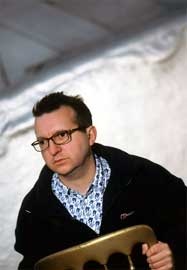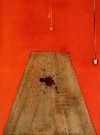Blood on the Floor
an encounter of classical and jazz by British composer Mark Anthony Turnage
By: Michael Miller - Aug 11, 2006
1Tanglewood Music Center Chamber Orchestra, July 31, 2006 8:30 PM, Seiji Ozawa HallMark Anthony Turnage, "Blood on the Floor"
Stefan Asbury, conductor, Peter Erskine, percussion, Martin Robertson, saxophone, John Parricelli, guitar
The Festival of Contemporary Music at Tanglewood closed on Monday, July 31 with Mark Anthony Turnage's "Blood on the Floor," a long, ambitious piece for chamber orchestra with expanded winds and percussion, and a jazz quartet consisting of soprano saxophone, solo electric guitar and bass, and percussion. Now a mature ten years old, the suite has enjoyed fairly frequent performances in Britain and the U. S. over the years, not only because of the composer's reputation, but clearly also because of its accessibility and quality. Both a recording and a DVD are easily available. Yes, "Blood on the Floor" is an essay in fusion, but in it Mr. Turnage avoids any trace of the clichés which often afflict such music and make it such an exercise in self-consciousness. He spares us any importunity to admire his cool. The piece as a whole is carried by the composer's gift for elegiac melody, the sincerity of the emotions expressed through them, and the imaginative sonorities which pervade the orchestration. All these values came across brilliantly under Stefan Asbury's direction, and, as always, the young players of the TMC Orchestra amazed the audience with their musicianship.
Already in the first bars Turnage establishes us in a world filled with sounds unlike anything one has heard in classical music, although they are founded on classical orchestration practices, constantly fascinating and pleasurable. When he moves in a more lyrical direction often the electronic guitar or soprano saxophone take the lead, as in the fourth movement, "Junior Addict," "Sweet and Decay," or the sixth, "Elegy for Andy," a touching lament for his brother, who died of a drug overdose, but, soon enough, the listener forgets to take stock of what musical territory he happens to be in and becomes immersed in Turnage's eloquent music—a summa of the musical culture of the late twentieth century, when drugs and music cohabited in a characteristic relationship—somehow manifesting itself like a memory when approached through this piece, however much both music and drugs may still be with us today. Nonetheless the loose suite structure of the nine movements is most identifiably classical, however ambiguous individual passages may strike the listener.
It is this experience of a time when different musical cultures met in a social milieu pervaded by drugs, their excitement and their degradation, and the despair that rose from it, that holds the nine movements together at a profound level rather than the expectations conditioned by Baroque orchestral suites. It is also, for Mr. Turnage at any rate, an artistically conscious world, evident in the cultivation and polish of his music, and in his openness to the other arts. Two movements are inspired by paintings: the first (written originally as an independent piece in 1993) was developed from Francis Bacon's late (1986) painting "Blood on the Floor," and the last, "Dispelling the Fears," was inspired by a work of his friend, the Australian painter Heather Betts. Readers of Langston Hughes will recognize his poem in the title and mood of the second movement, "Junior Addict," which so movingly expresses the misery of a boy oppressed by social inequality and heroin:
Quick, sunrise, come-
Before the mushroom bomb
Pollutes his stinking air
With better death
Than is his living here,
With viler drugs
Than bring today's release
In poison from the fallout
Of our peace.
This brings our journey into the underworld back to the 1960's. Still the most telling association of Turnage's work comes from within the world of music, his fascination with Miles Davis, which not only appears in his score, but in the unwritten riffs intended for his lead guitarist, who in the original performance was Davis' own John Scofield.
The audience received "Blood on the Floor" with ovations. As Turnage, who was present to receive them, mellows with the years, this surging confluence of anger, urban angst, and elegy continues to hold us.


